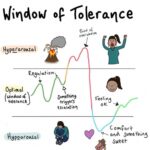The Pain Paradox: Why Facing Emotional Pain Is the First Step to Healing

Emotional pain is a universal human experience. Whether it arises from grief, loss, trauma, or disappointment, our natural instinct is often to protect ourselves from it—by pushing it away, denying it, or distracting ourselves with busyness or numbness.
In the moment, this can feel like self-preservation. But over time, avoiding emotional discomfort often deepens the very suffering we’re trying to escape.
This is the heart of the Pain Paradox—the idea that while pain warns us of danger and brings suffering, it can also be a powerful force for healing, transformation, and even inner peace. The paradox lies in the fact that the more we resist emotional pain, the more it persists. Yet when we turn toward it with honesty and compassion, we create the conditions for healing.
What We Resist, Persists
The phrase “What we resist, persists” perfectly captures this phenomenon. When we suppress or ignore painful emotions, they don’t disappear—they linger beneath the surface, quietly influencing our thoughts, behaviors, and relationships. Left unacknowledged, these emotions can grow stronger, manifesting as anxiety, depression, physical tension, or emotional reactivity.
By trying to avoid pain, we give it more power. It becomes the background noise of our lives—an unresolved tension that never quite goes away.
The Power of Acknowledgment
Healing begins when we stop running from our pain and instead meet it with presence and curiosity. Acknowledging our emotions—even the most uncomfortable ones—is not weakness; it’s courage. It’s saying, “I’m willing to feel this, to understand it, and to heal through it.”
This process doesn’t mean wallowing in pain or becoming overwhelmed by it. It means allowing ourselves to feel fully, to give space to our emotions without judgment. Paradoxically, by making room for pain, we often find that it softens. The act of facing it brings a sense of relief, clarity, and self-compassion.
Pain as a Catalyst for Growth
The Pain Paradox also suggests that emotional discomfort isn’t just something to survive—it can be a teacher. Pain often reveals what matters most to us. It signals where we need to heal, grow, or set boundaries. It invites introspection and connection.
Many people find that their most painful experiences ultimately lead to greater resilience, empathy, and a deeper understanding of themselves. This doesn’t mean pain is inherently good or desirable—but it does mean that it can hold meaning and potential when we engage with it intentionally.
The Mind-Body Connection
In the case of chronic pain, the Pain Paradox extends beyond emotions into physical experience. Chronic pain is often influenced by psychological and emotional factors, not just physical injury. Suppressed trauma, stress, and unresolved emotions can amplify or even trigger physical symptoms. In such cases, healing requires addressing the whole person—mind, body, and spirit.
Mindfulness, therapy, somatic practices, and emotional release techniques are powerful tools for integrating pain, rather than resisting it. These approaches don’t seek to eliminate pain immediately but to change our relationship with it—reducing its grip over time.
Moving Toward Healing
Pain is not the enemy. Avoidance is. By resisting our pain, we prolong our suffering. But by facing it—gently, patiently, and with support—we reclaim our power.
So the next time you feel the urge to escape emotional discomfort, pause. Breathe. Ask yourself: What am I feeling? What is this pain trying to show me? That moment of awareness could be the first step toward healing.



Comments (0)